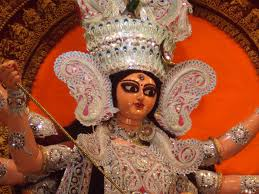Clik here to view.

Come October and there'd be nine days of festivities and six holidays to look forward to. I would be crazy if that wasn't a reason good enough for me to rejoice during my schooldays! Growing up in the northern plains of Allahabad and with almost zero connection with Bengali tradition, the most enchanting part of the Durga Puja holidays was the free time (which usually came after harrowing half-yearly examinations) and making the most of it.
While some non-Bengali parents planned foreign vacations during this time of year, my parents wisely made it a point to make us experience every bit of the festival, year after year, in a manner no less than a Bengali would. My allegiance to the festival thus started.
"[D]espite each venue brimming with high-spirited people, there was always a sense of respect and discipline."
My memories of Pujo are still crystal clear. Almost every other clearing in our small city was taken over by a colourful pandal; I was told that each one of these was endorsed by a core committee of Bengalis who worked for months to make the pandal as impressive as possible. They used breathtaking creativity to embellish these sites with vivid architectural and artistic details and scheduled - for all nine days -- fun-filled programmes comprising contests, quizzes, Rabindra sangeet and talent shows. Any flagging spirits were revived by the drive to win the "Best Pandal" trophy.
While some pandals were aesthetically crafted with customary Bengal motifs and designs, many were innovatively inspired from current happenings around the world. It wasn't surprising for me to note new themes almost every year - for example, one pandal had a tribal welfare theme in which Devi Durga wore the Garo mini skirt, another raised awareness about the environment, dressing the goddess in leaves and shoots. One pandal displayed life-size cut-outs of freedom fighters and another paid homage to Bollywood with Shah Rukh Khan and Aishwarya Rai posters all over the marquee.
As night fell, the Puja pandal became a cultural hotspot. Full of energy, high-end fashion, food fiestas, music, late-night fun and gossip sessions, the nights in our otherwise quiet city came to life. Yet, despite each venue brimming with high-spirited people, there was always a sense of respect and discipline. There was hardly ever any pushing or manhandling as devotees tried to catch a glimpse of Maa Durga's protima.
From my back-to-back visits to Durga Puja functions, I have come to deduce that food is central to a Bengali as much as dressing well is. Visiting a Puja venue and coming back without having indulged in some paani puri or jhaal-muri or Indo-Chinese chowmein from the street vendors queuing the roadside, meant an insult to the Bengali tradition of "must-have reech phood!" Whenever I bumped into a Bengali friend who would have made her temporary home for six days in one of these pandals, the first question she'd ask was whether I had tried the famous phish chop, roshogulla and bhishon bhalo coffee in one of the stalls.
Then there were the beautiful girls and women. They chatted and gossiped about all matters sartorial as they stood resplendent in their precisely draped saris, perfect make-up, large kohl-lined eyes, big bindis and enviable jewellery. Yet, the most outstanding aspect of their look would be their spark of grace, punctuated with spasms of boisterous laughter. Bengali women may not be the most beautiful on earth but they are certainly endowed with hypnotic looks that reach their peak in the Puja period, aided no doubt by a month-long shopping spree for themselves and their family.
Though the occasion was religious, the Puja pandals offered the best meeting places for would-be couples and dating pairs, sometimes even sparking matrimonial connections. It's not that surprising, of course - how could boys and girls getting together in their best finery for nine days and nine nights focus only on devotion?
On the sixth day of the festival, when the public would see Goddess Durga unveiled the first time, a strange excitement took over. Suddenly the frivolous fun and merry-making changed to a deeply devout and gratifying experience. My favourite part of the Puja was always eating bhog served at noon and watching the dhakis beat their drums and do dhunuchhir naach with torch lit with a fragrant dhun that surrounded us all by a mystical aroma. The rhythmic beating that gradually rose to a high crescendo filled me with immense powerfulness, bountiful love and ecstasy. Six days slipped like sand from the hand as if we lost touch with time, immersing ourselves in joyful days, wishing they never ended.
Alas! Amidst pompous fanfare and women playing sindoor, suddenly came Doshomi, the time to let the goddess go. When I sat on the ghats of the Ganga watching the last rites of Visarjan, my attention stopped at the beautifully sculpted face of Goddess Durga. How behind the drums beaten by dhakis, her beautiful big eyes, wavy black hair and curved lips gradually sank under water to melt into a muddy mesh, leaving behind a sombre crowd of devotees. There on the banks of the Ganga were hundreds of teary-eyed worshippers half drenched in the holy mud, bonding with each other through strings of rich cultural unity, hardly caring who was a Bengali or non-Bengali!
Image may be NSFW.
Clik here to view.
 Like Us On Facebook |
Like Us On Facebook | Image may be NSFW.
Clik here to view.
 Follow Us On Twitter |
Follow Us On Twitter | Image may be NSFW.
Clik here to view.